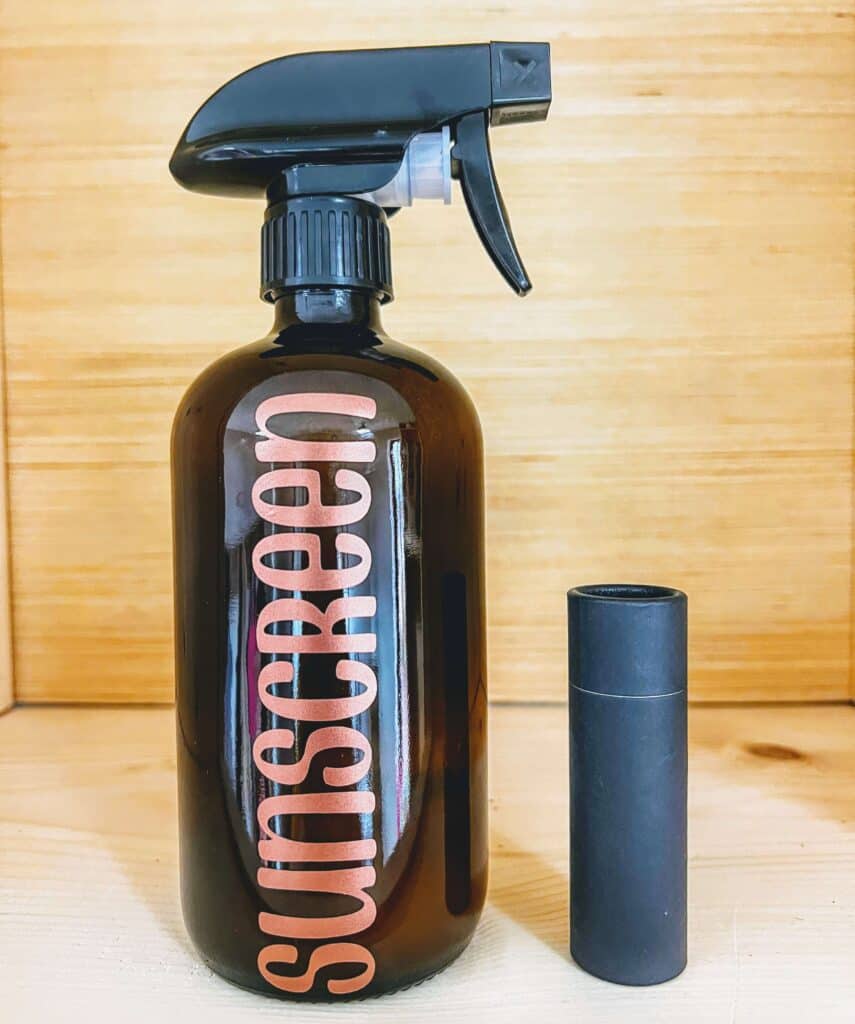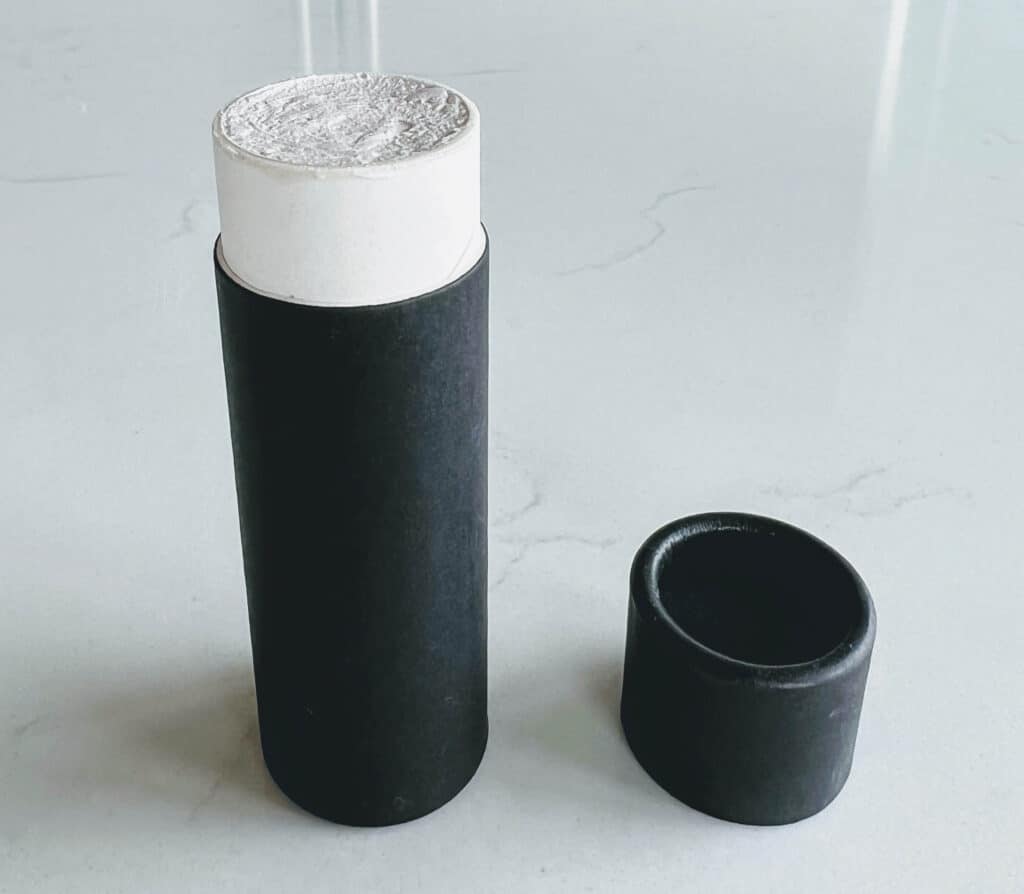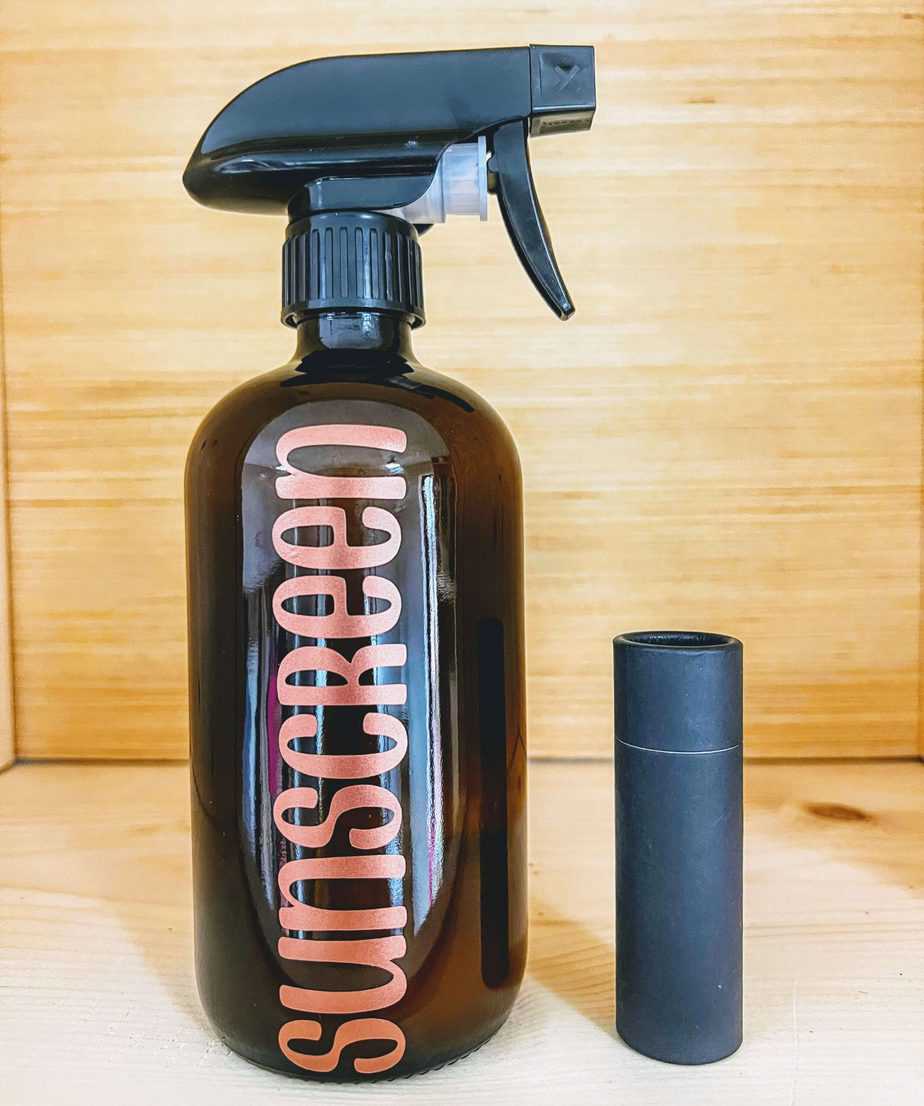This post may contain affiliate links. Please read our affiliate disclosure.
This homemade sunscreen recipe is quick to whip up and will help you avoid conventional sunscreens that are filled with harmful chemicals.

When my first baby was just 2 weeks old our new little family of 3 attended my sister’s ball game. It was a hot spring day. We sat underneath a shade canopy, carefully making sure that our precious baby was not in the sun.
But guess what? Her poor little face got burnt!
Later we found out that while the canopy used to have UV protection, the protective coating must have faded with use. While we were sitting in the shade, the UV rays were still coming through.
I felt like a horrible mother. And then, I spent the next 5 years making up for it by coating my children in every sun-blocking chemical labeled for use on kids.
When my oldest was nearing kindergarten I started to learn about the chemicals that most commercial sunscreens are made of. I started reading labels. Researching ingredients. And suddenly I felt that feeling of panic and guilt all over again.
I stopped using sunscreens filled with toxic chemicals and started using natural techniques for minimizing the harmful effects of too much sun exposure.
I stopped letting marketing campaigns and fear-mongering take away from the truth: sunshine is healing for the body, you just have to respect its power.
And I started experimenting with more natural ways of lessening the negative effects of getting too much sun.
Today I’m going to share why you should not be slathering your children (or yourself) in chemical sunscreens and several natural alternatives to using any sunscreen at all. I will also share my favorite coconut oil sunscreen recipe for those times when extra protection is desired.
Why Are Sunscreens Dangerous?
Many commercial sunscreens contain chemicals, such as oxybenzone, octinoxate, octocrylene, homosalate, avobenzone, and octisalate. We now know that these chemicals actually cause cancer and other health complications. Oxybenzone is also an endocrine disrupter according to many recent studies.
What did people do before sunscreen?
One of my sets of grandparents lived a very old-fashioned life. They were the OG homesteaders before homesteading was cool. One thing I remember distinctly about them was how they wore long sleeve shirts and long pants on the hottest of days – out in their garden! It was so strange to my shorts and tank top-wearing self.
The fact is, people of European descent have only recently started running around mostly naked in the sunshine. It was the norm in days past to keep most of your skin covered, especially outside. In fact, those who had tan faces were looked down upon, as it was a sign of poverty.
Even in countries and cultures where fewer clothes were worn, we can see how the people had concocted ways to protect them from sun damage before the days of commercial sunscreen.
For example, the Himba women of Namibia coated their hair and skin in a reddish paste called otjize. This paste was made by blending fat, butter, and red ochre, and served as both protection from the sun and insects.
It is also thought that Indians were the first ones to use zinc oxide on their skin as a natural homemade sunscreen. Zinc oxide is one of the main ingredients in most mineral-based sunscreen products as it has a natural spf.
The problem came when large companies decided to try to use chemicals in order to make a superior product to the natural ways people had been protecting their skin for generations. While those products may have served their purpose to block the sun, we now know that those chemicals were causing more harm than good.
Should we block sun exposure? What about vitamin D deficiency?
Oh man, do I even enter into this hotly debated topic? It also seems that the science around vitamin D and sun exposure seems to be constantly changing!
Here is what I know:
- We were designed to be outside in nature, not indoors.
- If a person were to be outdoors throughout the day, they would get their daily quota of Vitamin D even wearing some skin protection or long clothing.
- Morning sun is said to be the healthiest, and there is much less risk of skin damage.
- Vitamin D can also be obtained through diet. Salmon, tuna, egg yolks, and mushrooms are great food sources.
In a nutshell, yes you should get some sun! However, you can still use common sense regarding when and how much.
Our Sun Protection Routine
*This post contains affiliate links, which means I make a small commission at no extra cost to you. See my full disclosure here.
Our family lives in a very northern location where many people get pasty white in the winter. A few of my kids also have naturally fair skin and burn easily. I wouldn’t send these kids outside into the heat of the day, in the spring, for several hours, without protection from the sun. There are steps we can stake to both protect our skin from damage and enjoy those warm spring days.
As the weather warms up in the spring and early summer, we make sure to get our sunshine in the morning and evening. We refer to the time period between noon and 2, as “the burning hours” and try to spend time in the shade
When we do spend time outdoors during these “burning hours,” these are times when we use sunscreen. We opt for all-natural mineral sunscreens such as our own homemade version, or a store-bought one with zero added chemicals.
Eating a healthy whole food diet is also an important part of keeping our skin safe from sun damage. Thankfully, all of the fresh foods we love in summer, like tomatoes and blueberries, are capable of providing some protection.
As we get further into summer, our skin builds up its own natural protection against skin damage – melanin! Melanin is responsible for the pigmentation when you get a tan. It also protects your skin from the harmful effects of the sun. Even with tans, we are still more cautious during those “burning hours” or when we are swimming.
Homemade Coconut Oil Sunscreen
In full disclosure, homemade sunscreen will not function like commercial sunscreen. There are just things fancy labs can whip up that we can’t do at home. In the case of chemicals, I’m grateful for this! This is not to discourage you, but simply to help you keep healthy expectations.
Homemade sunscreen will give your skin a bit of a white tint. The cocoa powder in this recipe is to help combat this, but this won’t be a good solution with light-colored clothing, as it may stain.
Also, this will need to be reapplied frequently if you are using it at the beach or a pool as it is not completely waterproof. It is also not the high SPF (sun protection factor) that is generally recommended for long-term sun exposure.
Despite these things, we love this simple recipe for homemade sunscreen. It is easy to make and a fun DIY project to prepare for summer. With a large family, making our own sunscreen also saves us money.
How to Make Homemade Coconut Oil Sunscreen
First, you will need to gather your ingredients. You will need:
- Fractionated coconut oil: this is coconut oil that is liquid at room temperature. You won’t find this at the grocery store. This is especially important for the spray sunscreen so that it isn’t too thick.
- Sweet almond oil
- Beeswax pellets (not used in the spray)
- Carrot seed essential oil
- Myrrh essential oil
- Red raspberry seed essential oil
- Non-nano zinc oxide
- Non-nano titanium dioxide
- Cocoa powder (optional)
- Empty spray bottle (for spray version)
- Empty large chapstick or deodorant dispenser (for stick version)
Next, you will need to decide what type of sunscreen makes the most sense for your family. We like to make both the sunscreen stick and the spray. We use the stick on faces and more sensitive areas. The stick is also more water-resistant.
With 7 kids, the spray sunscreen is very handy. We use this on areas like arms and legs.
How to Make Homemade Coconut Oil Stick Sunscreen
Before you begin making this recipe, I recommend putting on a face mask that will protect you from inhaling any of the zinc oxide or titanium dioxide. These are perfectly safe on your skin, as they don’t absorb, but they are not safe to be inhaled.
To make the homemade coconut oil stick sunscreen, start by melting ¼ cup beeswax pellets in a double boiler. If you don’t have a double boiler, you can improvise by placing the pellets in a glass jar and holding the jar in a pot of simmering water while stirring.
Next, add the almond oil and fractionated coconut oil and stir until well combined.
Turn off the heat, but don’t remove the pot from the stove. Then add in the titanium dioxide, zinc oxide, and cocoa powder. Stir until well combined.
The cocoa powder is completely optional, but I have found that it helps the sunscreen not give the skin a white appearance. You can adjust the amount of cocoa powder to match your skin tone. Just be careful if using the cocoa powder (especially if you add more) with light-colored clothing, as it may stain.
Then, remove your bowl or jar from the heat and stir in the essential oils. These specific essential oils were chosen for their natural sun-blocking and skin-soothing properties. There are other great oils with these properties, however, so feel free to mix them up. Just don’t use any citrus oils, as they will make your skin more sensitive to the sun’s rays. See the note below on the safety of these oils if you are pregnant.
Once your mixture is well blended you can pour it into the container of your choice. I like the convenience of using a large chapstick or deodorant dispenser, as I can just rub them on my child’s skin. The large chapstick container works great as a face stick!

You can also use a small jar and use your fingers to apply the homemade sunscreen. This is a thicker consistency, but if you are looking for more of a body butter consistency you simply need to reduce the amount of beeswax pellets.
The beeswax in this recipe helps the homemade sunscreen to be more water-resistant, but reducing the amount won’t affect the SPF.
Immediately after mixing well, place the sunscreen-filled container into a freezer. This allows the mixture to harden before the minerals have a chance to sink to the bottom.
Finally, remove your homemade sunscreen from the freezer and store it in a cool place. When taking the stick version to the beach, place it in a cooler so that it doesn’t melt!
How to Make Homemade Coconut Oil Spray Sunscreen
To make the spray sunscreen, follow the instructions above, simply leaving out the beeswax pellets. This means that there are no oils to melt, as these oils are already liquid. However, heating up the mixture slightly helps to blend the ingredients together.
After you have the ingredients well mixed, pour them into a spray bottle. The mixture will come out in more of a stream than a fine mist, so it will still need to be rubbed in by hand. Despite this, the spray is still very convenient when applying homemade sunscreen to several kids!


Homemade Coconut Oil Sunscreen Recipe {Spray and Stick Options}
Ingredients
- ⅓ cup fractionated coconut oil liquid at room temperature
- ¼ cup almond oil
- ¼ cup beeswax pellets omit for making the spray
- 15 drops carrot seed essential oil
- 15 drops myrrh essential oil
- 15 drops red raspberry seed extract
- 2 Tablespoon zinc oxide
- 1 Tablespoon titanium dioxide
- 1 tsp. cocoa powder optional
Instructions
- First, decide to either make the spray sunscreen or the stick. We make both, using the stick on faces and more sensitive areas. We use the spray on areas like arms and legs since it is easy to apply a larger amount.
- If you are making the stick, start by melting the beeswax pellets in a double boiler. If you don't have one, you can improvise by placing the pellets in a glass jar and holding the jar in a pot of simmering water while stirring. If you are making the spray, simply skip this step.
- Next, add the almond oil and fractionated coconut oil and stir until well combined. If you are making the spray, begin by slowly heating up these oils on low heat.
- Turn off the heat, but don’t remove the pot from the stove. Then add in the titanium dioxide, zinc oxide, and cocoa powder. Stir until well combined.
- Remove your bowl or jar from the heat and stir in the essential oils. These specific essential oils were chosen for their natural sun-blocking and skin-soothing properties. There are other great oils with these properties, however, so feel free to mix them up. Just don't use any citrus oils, as they will make your skin more sensitive to the sun's rays.
- Once your mixture is well blended you can pour it into the container of your choice. I like the convenience of using a large chapstick or deodorant dispenser, as I can just rub them on my child’s skin. The large chapstick container works great as a face stick!
- Immediately after mixing well, place the sunscreen-filled container into a freezer. This allows the mixture to harden before the minerals have a chance to sink to the bottom.
- Remove from the freezer and store in a cool place. When taking the stick version to the beach, place it in a cooler so that it doesn't melt!
Notes
Is homemade sunscreen safe for pregnancy?
Yes, if you leave out the essential oils. There is a lot of debate on the safety of using essential oils during pregnancy. Carrot seed oil and myrrh are specifically not recommended by most aromatherapy experts. Red raspberry seed oil is one I would not personally use, as I know how effective red raspberry leaf tea is in causing contractions. However, this is based on personal experience alone and not on any studies I could find.
The use of zinc oxide and titanium dioxide on your skin during pregnancy is considered perfectly safe, as long as you are using non-nano versions of these minerals. Nanoparticles are not safe, as they are capable of being absorbed by the skin.
Also, keep in mind that the natural changes in your body that occur during pregnancy make you more susceptible to skin damage from the sun. I recommend being extra cautious about not being out in direct sunlight during the middle of the day.
Can I make homemade sunscreen without zinc oxide or titanium dioxide?
You can leave out one of them, but not both. Zinc oxide is the key ingredient. Titanium dioxide is another mineral with natural sunblocking properties. For best results, use both. If just choosing one to purchase, go with zinc oxide.
I hope you love this homemade coconut oil sunscreen! If you try it out, please let me know what you think.

Sunscreens are such an issue for us and this recipe might be a life-saver. My daughter is allergic to tree nuts and many of the ‘safer’ sunscreens. Unfortunately, they contain another food she is allergic to – avocado oil, so we can’t use those either. Is the almond oil just for scent? What about the carrot oil (I’m allergic to carrot)? Can either the almond or carrot oils be substituted for something else?
Thank you so much for these wonderful recipes and all of the guidance you provide 🙂
Oh, I’m sorry that you deal with so many allergies! I would suggest replacing the almond oil with another oil that is liquid at room temperature such as fractionated coconut oil. I’ve never tried it this way, so I would do a very small batch to test and make sure the consistency is correct. I hope this helps!
Excited to give this a try! Thank you for sharing. Also wondering what you make your labels with?
So glad you like it! I used a Cricut to make my labels.
What would you say the SPF is for this sunscreen remedy?
Since it’s a DIY recipe, it’s hard to give an exact SPF rating. But generally, zinc oxide offers broad-spectrum protection, and the amount you use can give you an SPF range of 20-30. Just be sure to apply it generously and reapply often, especially after swimming or sweating.